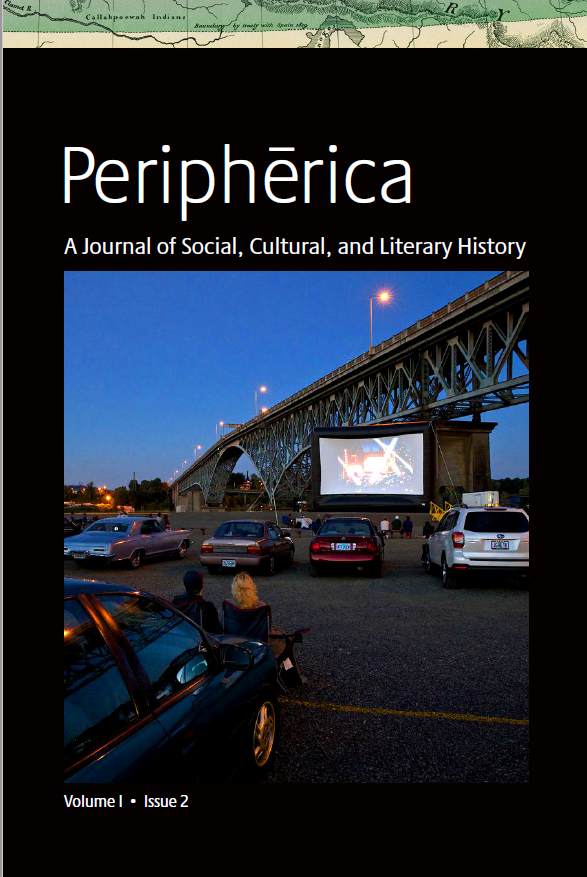Spaces and Journeys in Ernesto Daranas’ <i>Conducta</i>: Che or Martí?
DOI:
https://doi.org/10.5399/uo/peripherica.1.2.6Resumo
In his film Conducta (Behavior 2014), Ernesto Daranas portrays the ethical and physical challenges of an aging teacher, struggling to improve the lives of her students, not just within the classroom setting, but also in their family and social spheres. Thus, in response to a top/down social structure where an unseen government exerts economic and political pressure on schools and families in crisis mode, Daranas proposes model redirecting away from Ernesto Che Guevara and back toward José Martí as a pedagogic strategy for modulating conduct expectations of elementary school children. However, because government censorship sensitizes the spoken word, the filmmaker is careful to avoid negative repercussions by letting markedly visual elements of his mise en scène reveal indiscreet, if not outright subversive views of home, school, and cityscape. Also, through a recurring wandering narrative format, Ernesto Daranas conducts a political inquiry analogous to how Radicant aesthetics exercise wandering narratives.Referências
Bourriaud, Nicolas. The Radicant. Lukas & Sternberg, 2009.
Conducta. Directed and written by Ernesto Daranas, performance by
Armando Valdés Freire, Alina Rodríguez and Amaly Junco, RTV Comercial and Instituto Cubano del Arte e Industria Cinematográficos (ICAIC), 2014.
Doble juego. Directed by Rudy Mora, written by Olga Consuegra and Rudy Mora, performance by Mónica Alonso, Liety Chaviano, Corina Mestre, Raúl Pomares, Miriam Socarrás and Broselinda Hernández, Embajada de Cuba and ICAIC, 2002.
Havanastation. Directed by Ian Padrón, written by Felipe Espinet, performance by Claudia Alvariño, Rubén Araujo and Blanca Rosa Blanco, Ministerio de Cultura de Cuba, el Instituto Cubano de Radio y Televisión (ICRT) and (ICAIC), 2011.
Guevara, Ernesto Che. Che Guevara Talks to Young People, edited by Mary-Alice Waters, Pathfinder, 2007.
Guantanamera. Directed by Tomás Gutiérrez Alea and Juan Carlos Tabío, performance by Mirta Ibarra and Jorge Perugorría, ICAIC, 1995.
Guerra, Wendy. Todos se van. Bruguera, 2006.
Jameson, Fredric. "Third-World Literature in the Era of Multinational Capitalism." Social Text, 1986, pp. 65-88, www.jstor.or/stable/466493. Accessed 26 May 2015.
Mañach, Jorge. Martí: The Apostle of Freedom, Devin-Adair, 1950.
Martí, José. La Edad de Oro. 1889, Editorial Gente Nueva, 1979.
--- . Versos sencillos / Simple Verses, translated with introduction by Manuel A. Tellechea, Arte Público Press, University of Houston, 1997.
“Our Lady of Charity of El Cobre.” CatholicSaints.Info, 31 December 2008, www.catholicsaints.info/our-lady-of-charity-of-el-cobre. Accessed 10 June 2015.
Oxford Dictionary, www.en.oxforddictionaries.com/definition/radicant. Accessed 5 December 2018.
Pardo Lazo, Orlando Luis. Boring Home. Garamond, 2009.
Scaperlanda, María Ruiz. “Island Queen: A reflection on Our Lady of Charity.” US Catholic, 7 September 2011,
www.uscatholic.org/church/2011/09/island-queen-reflection-our-lady-charity. Accessed 28 April 2017.
“The miracle of marabú, Cuba’s wonderful weed.” The Economist, 1 June 2017, reprint, www.economist.com/the-americas/2017/06/01/the-miracle-of-marabu-cubas-wonderful-weed. Accessed 11 December 2018.
Una noche. Directed and written by Lucy Mulloy, performance by Dariel Arrechaga, Anailín de la Rúa de la Torre and Javier Núñez Florián, Mulloy Productions, 2012.
Wiessert, Will and Paul Haven. “Cuba to Cut 500,000 Government Workers, Reduce Restrictions on Private Enterprise.” The World Post, www.huffingtonpost.com/2010/09/13/cuba-government-layoffs-private-enterprise_n_715681.html. Accessed 19 September 2015.



